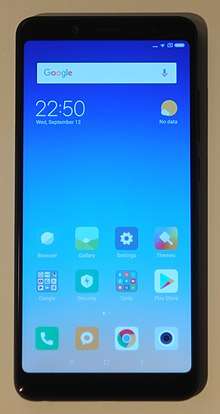MIUI
MIUI (pronunciation: Me You I),[1] is an Android-based operating system[2] for smartphones and tablet computers developed by Chinese electronics manufacturer Xiaomi. This is a fork of the Android OS.[3] MIUI includes various features such as theme support.[4]
| Developer | Xiaomi |
|---|---|
| Written in | C, C++, Java |
| OS family | Android 5-10 (Unix-Like) |
| Working state | Current |
| Source model | Open source (Android Base and Main Framework) with Proprietary components (Miui Apps and Kits) |
| Initial release | 0.8.16 / 16 August 2010 |
| Latest release | 12.0.8.0 (Mainland China) 12.0.3.0 (Global market) |
| Latest preview | 13 August 2020 / [12] 20.8.13 (Mainland China) |
| Marketing target | Alternative OS replacement for Android devices; Stock firmware for Xiaomi mobile devices |
| Available in | 77 languages (varies by country) |
| Package manager | Google Play Mi GetApps .APK files |
| Platforms | 32-bit ARM, MIPS, x86, x64 |
| Kernel type | Monolithic (modified Linux kernel) |
| License | Apache License 2.0 GNU General Public License v3 Proprietary |
| Official website | en |
Xiaomi has released some smartphones with Android One while others have MIUI, based on the current version of Android. Xiaomi devices usually get one Android version update, but get MIUI updates for four years.[5]
The first MIUI ROM was based on Android 2.2.x Froyo and was initially developed in the Chinese language by Chinese startup Xiaomi Tech.[6] Xiaomi added a number of apps to the basic framework, including their Notes, Backup, Music, and Gallery apps.[7]
MIUI vs Android
Although the MIUI is built on the Android platform, the default user interface of its earlier iterations resembled iOS due to the absence of the application tray,[12] with a grid of icons arrayed in the home panels. Other iOS similarities include the app icons being in a uniform shape, the dialer and in-call interface, the organization of the Settings app, and the visual appearance of toggles in the UI. This prompted some observers to cite how the devices running on MIUI could appeal to iOS users wanting to switch to the Android platform.[12] By 2018, MIUI was increasingly shifting towards a design aesthetic more similar to the stock Android. For instance, several elements in the MIUI 10 build resemble Android Pie features such as the multitasking menu and gesture controls.[13] This change was first seen in the MIUI 9 (ver. 8.5.11) that shipped with the Xiaomi Mi Mix 2S. The MIUI firmware already looked like stock Android P.[14]
Another difference from Android is the MIUI's support for themes and custom fonts. Users can download theme packs and fonts, which can change the user interface of the device once installed from the Mi Themes Store. It allows advanced users to tweak the hard-coded firmware of their handsets.[15]
Issues
MIUI's kernel was proprietary, and in breach of Linux kernel's GPL.[16][17] Source code for certain components was released to GitHub on 25 October 2013.[18] Kernel sources for a few devices, including the Mi3, Mi4, MiNote, and Redmi 1S, were released in March 2015.[19]
In order to raise funds for the company, MIUI has its own online services from Xiaomi, including cloud services, paid themes and games. Payments are transacted using the MiCredit digital currency.[20]
Version history
| Version | Screenshot | Android version | Date of release | Last Stable release | Initial Beta release | Last Beta release | Notable change |
|---|---|---|---|---|---|---|---|
| MIUI V1 | 2.1 |
16 August 2010 | N/A | 0.8.16 | Unknown | Initial release | |
| MIUI V2 | 2.1-2.3.6 |
Unknown | N/A | Unknown | Unknown | Redesigned user interface | |
| MIUI V3 | 2.3.6 | Unknown | N/A | Unknown | 2.4.20 | Redesigned user interface | |
| MIUI V4 | 4.0.4 – 4.1.2 | Unknown | ICS24.0[23] | Unknown | 3.2.22 |
| |
| MIUI V5 | 4.1.2 – 4.4.2 | 1 March 2013[24] | 31.0[25] | 3.3.1 | 4.12.5 |
| |
| MIUI 6 |  |
4.4.2 – 5.0.2 | 29 August 2014[26] | 6.7.2.0 | 4.8.29 | 5.8.6 | New user interface |
| MIUI 7 |  |
4.4.2 – 6.0.1 | 13 August 2015[27] | 7.5.9.0 | 5.8.12 | 6.5.26 | Locked bootloader on selected old devices and all released afterwards |
| MIUI 8 |  |
4.4.2 – 7.1.1 | 16 June 2016[28] | 8.5.10.0 | 6.6.16 | 7.7.20 |
|
| MIUI 9 |  |
4.4.2 – 8.1.0 | 10 August 2017 | 9.6.5.0 | 7.8.10 | 8.5.24 |
|
| MIUI 10 |  |
6.0 – 9.0 | 19 June 2018[29] | 10.4.5.0 | 8.6.14 | 9.9.6 |
|
| MIUI 11 |  |
7.0 – 10.0 | 22 October 2019 | 11.0.14.0 | 9.9.24 | 20.3.26 |
|
| MIUI 12 | 9.0 – 10.0 | 27 April 2020 | 12.0.8.0 | 20.4.27 | 20.8.x |
| |
See also
- List of custom Android firmware
- Comparison of mobile operating systems
- List of free and open-source Android applications
References
- About MIUI Video on YouTube
- Xiaomi Mi 9 User Guide
- http://tech.sina.com.cn/t/2011-07-28/01255847379.shtml
- MIUI Official English Site, en.miui.com, archived from the original on 15 February 2014, retrieved 16 March 2014
- Xiaomi Phone with MIUI OS: a $310 Android with 1.5 GHz dual-core SoC and other surprises, Engadget, 16 August 2011, retrieved 17 September 2011
- Jason Lim, MIUI, Lei Jun, TechNode, retrieved 17 January 2012
- MIUI Official English Site, archived from the original on 9 April 2014, retrieved 12 April 2014
- "Android – Certified - Partners". Android. Retrieved 31 January 2020.
- Forum, Xiaomi MIUI Official. "Mi Picks - pick your next favorite- officially launched! Give us your feedback! - App - Xiaomi MIUI Official Forum". en.miui.com. Retrieved 15 February 2018.
- "MIUI ROM Downloads". en.miui.com. Retrieved 28 April 2018.
- "MIUI 9 - 7.8.10 - First Miui 9". Xiaomi European Community & Store. Retrieved 19 September 2017.
- Black, Marie. "What's the difference between TouchWiz, MIUI, EMUI, OxygenOS, LG UX and standard Android?". Tech Advisor. Retrieved 31 July 2018.
- "MIUI 10 To Offer Updated Design, Its User Interface Leaks | Androidheadlines.com". AndroidHeadlines.com |. 29 May 2018. Retrieved 31 July 2018.
- "Latest MIUI 9 build for the Xiaomi Mi Mix 2 brings Android P-style UI changes". xda-developers. 11 May 2018. Retrieved 31 July 2018.
- Pfeffermann, Nicole; Gould, Julie (2017). Strategy and Communication for Innovation: Integrative Perspectives on Innovation in the Digital Economy. Cham, Switzerland: Springer. p. 30. ISBN 9783319495408.
- "小米的MIUI被指违反GPL许可证" (in Chinese). Solidot. 21 November 2012. Retrieved 6 August 2013.
- "MIUI is accused of non-compliance with free software license, users request MIUI to be free software (MIUI被指责不遵守开源软件协议,网友要求公开源代码)" (in Chinese). tech2ipo. 21 November 2012. Archived from the original on 3 March 2016. Retrieved 6 August 2013.
- "Commits". GitHub. 25 October 2013.
- GitHub MiCode/Xiaomi_Kernel_OpenSource, GitHub, 31 March 2015, retrieved 8 April 2015
- "删除谷歌,内置杀毒,MIUI终于突破底线".
- Wright, Arol (8 August 2020). "Xiaomi is rebuilding MIUI for India without any of its banned apps". xda-developers. Retrieved 8 August 2020.
- "Xiaomi India working on new MIUI version without banned Chinese apps". Android Police. 7 August 2020. Retrieved 8 August 2020.
- "MIUI Official English Site - Redefining Android". 6 December 2013. Archived from the original on 6 December 2013. Retrieved 22 May 2018.
- Forum, Xiaomi MIUI Official. "MIUI ROM 3.3.1 Changelog: MIUI V5 for Xiaomi MI2 Released!!! - MIUI General - Xiaomi MIUI Official Forum". en.miui.com. Archived from the original on 11 February 2017. Retrieved 10 February 2017.
- Forum, Xiaomi MIUI Official. "MIUI Stable ROM (Global) KXDMIBF22.0 for MI3-WCDMA/CDMA Changelog & Download - Xiaomi Mi 3 - Xiaomi MIUI Official Forum". en.miui.com. Archived from the original on 6 May 2018. Retrieved 5 May 2018.
- Forum, Xiaomi MIUI Official. "MIUI ROM 4.8.29 Full Changelog. MIUI 6 Released for Public! (Released) - MIUI General - Xiaomi MIUI Official Forum". en.miui.com. Archived from the original on 11 February 2017. Retrieved 10 February 2017.
- Forum, Xiaomi MIUI Official. "About MIUI 7 China ROM 5.8.13. What Device Will MIUI 7 Global ROM Support First? - MIUI General - Xiaomi MIUI Official Forum". en.miui.com. Archived from the original on 11 February 2017. Retrieved 10 February 2017.
- Forum, Xiaomi MIUI Official. "MIUI 8 China Developer ROM 6.6.16 Full Changelog & Supported Devices - MIUI General - Xiaomi MIUI Official Forum". en.miui.com. Archived from the original on 11 February 2017. Retrieved 10 February 2017.
- "MIUI 10首批机型公测下载 - MIUI官方网站". www.miui.com. Retrieved 21 June 2018.
- https://www.xda-developers.com/miui-11-new-features/
- https://www.techindeep.com/miui-12-1-coming-soon-here-are-all-the-whats-new-58927

